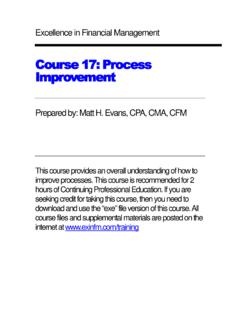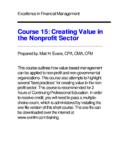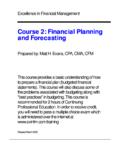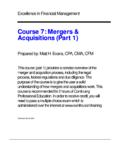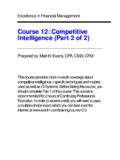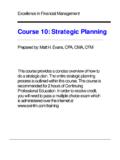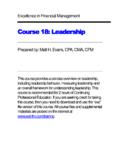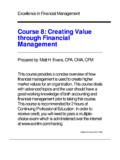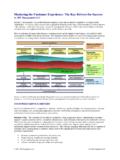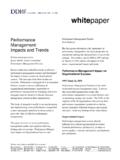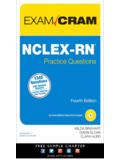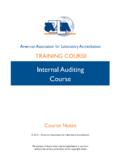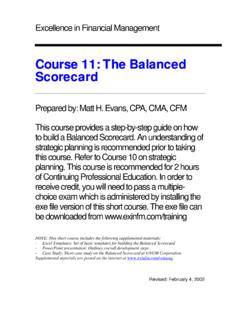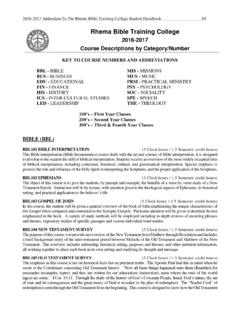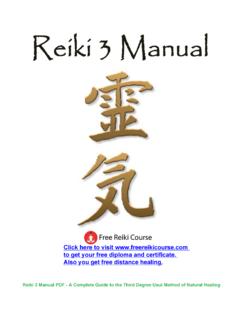Transcription of Course 12: Competitive Intelligence (PIntelligence (Part 1 ...
1 Course 12: Competitive Course 12: Competitive Course 12: Competitive Course 12: Competitive Intelligence (PIntelligence (PIntelligence (PIntelligence (Part 1 of 2) art 1 of 2) art 1 of 2) art 1 of 2) Prepared by: Matt H. Evans, CPA, CMA, CFM This Course provides an overview of how Competitive Intelligence works, including some of the techniques used to conduct Competitive Intelligence . This Course is recommended for 2 hours of Continuing Professional Education. In order to receive credit, you will need to pass a multiple-choice exam which is administered by installing the exe file version of this short Course . The exe file can be downloaded from Note: This Course continues with Part 2 Analytical models, CI Systems, and more advanced topics. Excellence in Financial Management 2 Basic Concepts There is a Chinese saying: Know thy-self, know thy competition, and get it right almost every time. Know thy-self, not know thy competition, and get it right about half the time.
2 Not know thy-self, not know thy competition, and get it wrong almost every time. We now live in a world driven by hyper-competition. Hyper-competition is where too many businesses are pursuing too little business; there is not enough demand to go around for all providers of goods and services. The knowledge base for managing in this hyper- Competitive environment is called Competitive Intelligence . Competitive Intelligence is a process of giving you insights into what might happen in the near future. This process requires that we go from data to information to Intelligence . Here is a basic example: Data => Prices for our products have dropped by 5% Information => New offshore facilities have lower labor costs Intelligence => Our key competitor is about to acquire a facility in India that will .. The differences between data, information, and Intelligence can be subtle, but very real: Data => Unconnected pieces of information: Nice to know, but so what! Information => Increased knowledge derived by understanding the relationships of data: Interesting, but how does it relate to what I do!
3 Intelligence => Organizing the information to fully appreciate the implications and impact on the organization: Oh really, then we better do something! Intelligence differs from data and information since it requires some form of analysis. The purpose of this analysis is to derive some meaning from the piles of data and information that bury everyone. By going through analysis and filtering, we can refine it enough so that someone can act on it and understand their options, giving them an opportunity to make forward-looking decisions. When we present Intelligence to people, they can draw a conclusion and make an important decision quickly. Therefore, Competitive Intelligence should put conclusions and recommendations up front with Chapter 1 Knowledge is what you are after. Information is the raw material you use. Intelligence is what finds and processes information. - The Intelligence Edge by George Friedman, Meredith Friedman, Colin Chapman and John S. Baker, Jr.
4 3supporting research behind the analysis. Competitive Intelligence should not simply present the facts, declaring what we found; but instead make a statement, saying this is what we believe is about to happen. Competitive Intelligence (CI) pulls together data and information from a very large and strategic view, allowing you to predict or forecast what is going to happen. This in turn allows you to effectively strategize in relation to your Competitive environment. Therefore, Competitive Intelligence allows you to remain Competitive by improving your strategic decisions and this leads to better performance against your competitors. Competitive Intelligence does not attempt to collect and analyze all information for an exact picture, but attempts to get enough information so that we can tell what s going on. It s like a picture that is out-of-focus. We need to analyze enough details so we can discern the big picture and report it to management. Therefore, Competitive Intelligence does not chase down all the facts, but gets enough information to draw a reasonable conclusion for immediate action.
5 Competitive Intelligence has some basic forms, such as market research and benchmarking. However, good Competitive Intelligence goes beyond simple research. For example, Competitive Intelligence attempts to answer specific critical questions that can impact your organization: How is the competitor XYZ able to grow and capture market share? What new products will competitor ABC develop and when will they release these new products? What are the core competencies of competitor DEF? Can we compete with new business lines or should we acquire another company to establish our market presence? Many equate Competitive Intelligence with other disciplines, such as business Intelligence and knowledge management. Although there are major overlaps between all of these disciplines, Competitive Intelligence tends to be very analytical, very intense, and very savvy in its approach whereas knowledge management and business Intelligence are more automated through technology and less dynamic than Competitive Intelligence .
6 However, as Competitive Intelligence becomes main-stream thinking, all of these disciplines begin to merge. So why hasn t Competitive Intelligence grown into a basic competency within most organizations? One contributing factor has to do with how Competitive Intelligence gets done. Good Competitive Intelligence requires old-fashioned analysis and filtering, somewhat like a detective who wants to solve a case you can t automate the art of The Evolution of Competitive Intelligence Key Point Intelligence should be Actionable Unless someone can take some form of action from knowledge, then your really do not have Intelligence . 4solving a crime and you can t automate the insights derived from Competitive Intelligence . It takes very intense and serious focus in a very short period of time. And this type of skill set is not common in many organizations; especially where Competitive Intelligence receives little or no emphasis. No organization can sit still and expect things to be the same month after month, year after year.
7 At some point, something will happen to change your assumptions. And almost every decision (especially a strategic decision) is based on certain assumptions. Over time, these assumptions fall apart and if you fail to adjust with a continuous flow of new Intelligence , then you will be forced to react in a way that makes it difficult to compete. Therefore, Competitive Intelligence can help test and validate your assumptions. Competitive Intelligence also fills in gaps, covering areas that you failed to consider in your assumptions. And of Course , Competitive Intelligence can yield some basic benefits: Source for best practices the only real way to isolate and find best practices is to engage in some form of Competitive Intelligence ; otherwise you end up relying on crude and generic type benchmarking data. Helps formulate strategy through an understanding of your industry, yourself, and your competitors. Competitive Intelligence is the essence of strategic business analysis!
8 Helps identify areas for improvement as well as risks and opportunities. Isolates performance gaps in relation to the competition. The Importance of Competitive Intelligence Competitive analysis is critical for managers formulating corporate or divisional strategies. Executives and planners must be aware of the levels and trends in performance of their competitors to determine the best direction for their divisions and parent corporations. They also must be capable of critically assessing their own organization s performance, over time, relative to its Competitive peers. Corporate Strategy by John L. Colley Jr., Jacqueline L. Doyle and Robert D. Hardie Regardless of the tools you use, the single indispensable element to CI is the human factor: the smarts, experience, and instinct that can turn huge collections of dead facts into live Intelligence that plays a central part in making business decisions. The best Competitive Intelligence team, experts agree, is one that is distributed, involving the company s entire workforce.
9 - Special Report: Competitive Intelligence Smart Business Magazine, March 2001 5 In their book Outsmarting the Competition, authors John J. McGonagle, Jr. and Carolyn M. Vella provide these guidelines on when to use Competitive Intelligence : Competition increases from firms outside your industry s traditional boundaries. Competition, both actual and potential, increases from firms. Consumers and customers become increasingly sophisticated and knowledgeable, demanding more and openly comparing products, services, and sources. Changes occur continuously in the nature and variety of the products and services you must offer to continue to compete. Significant changes occur in the ownership or senior management of firms in your industry, which may bring in new operating or marketing philosophies. Competitive Intelligence follows a two-phase process when it comes to collecting information: Phase I: Secondary Research (80% volume / 20% time) Phase II: Primary Research (20% volume / 80% time) Phase I Secondary Research leads to Phase II Primary Research.
10 Secondary research consists of press releases, analyst reports, trade journals, regulatory filings, transcripts of speeches, and other published sources of information. The bulk of the information (let s say 80% of it) that we collect comes through secondary research. Once we sift through this information overload, we can move to Phase II where the golden nuggets of Competitive Intelligence reside. Phase II Primary Research is more hands-on and direct, interviewing sources of published information, meeting face-to-face with key decision makers and flushing out the critical unknowns not found in secondary research. It is here, primary research, where we should spend most of our time (80%) on the pertinent information (20%) derived from secondary research. Therefore, we should recognize the 80 / 20 rule of Competitive Intelligence : Spend less of your time gathering the information and spend more of your time analyzing and refining it through primary research. The 80 / 20 Rule Primary vs.
